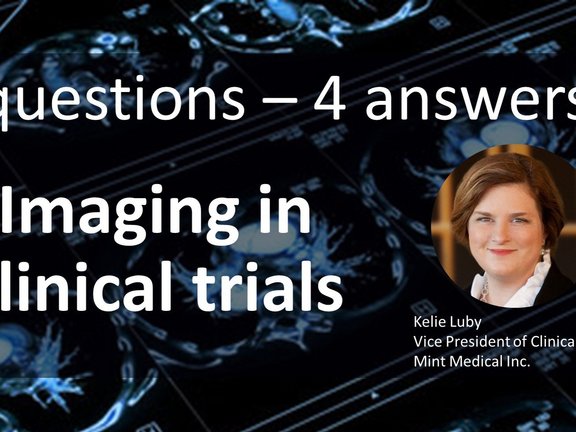Mint Medical, Inc. Vice President of Clinical Trials, Kelie Luby Discusses Advances in Imaging Analysis in Clinical Trials and What’s Next for Mint Medical
- What advancements in imaging analysis in clinical trials do you think have been most impactful in the past several years?
The first significant factor, one that is often overlooked but has had a major impact on the advancement of image analysis in clinical trials, is the speed of image transmission. Sending images on CDs is a topic of historical interest. Within the last 15 years or so, clinical trial teams have seen the evolution of image acquisition from the time consuming manual import of images on CDs to the semi-automatic upload and de-identification via the internet. This advancement has now left very few sites globally that cannot or will not send images electronically, which is drastically re-shaping the way clinical trial imaging reads are performed centrally.
Just the other day, I was trying to explain to my kids how internet used to work 20 years ago. They have no concept of a dial-up modem, a stationary desktop as the only source of connection to the world wide web, and waiting for that connection. The technology they have access to grants them automatic WIFI in every room in the house, in the car on the way to school, and even on the soccer field. In very much the same way, we are growing accustomed to this expansive wait-free environment as the acquisition and transmission of images becomes more seamless. In a clinical trial, when a patient is scanned, there is someone expecting to receive that scan within the same day, read the scan by the second day, and report back to the investigator and patient by the third day.
In central review as conducted by imaging core labs, this has had a dramatic effect. Because of this immediate need for results, we do not see cases being read in batches as much anymore. Clinical trial sponsors do not want to wait until years after the trial is complete to read images. Patient images are read in real time and results are given in real time. Why wait for your clinical trial to be complete before you see a progress report? The major benefit of this is that you do not end up with scans that were acquired incorrectly years down the line and you can minimize issues with image quality early on in the trial. Patients can also be read in real time for eligibility such as meeting measurable disease criteria by RECIST 1.1. This has a major impact on the evaluable patient population in a trial as well – it is inefficient and frankly unconscionable to get to the end of a trial and realize 20% or more of your patient population was not actually eligible because they did not meet radiologic protocol criteria or had image quality issues.
The second major advancement would be the quality and robustness of radiology reads. The industry has made great efforts to improve radiology review software for criteria specific analysis such that it reduces variability and allows the radiologists to keep their eyes on the images and allowing the software to guide them through the assessment. At Mint Medical, this has always been our core goal: Let the radiologist focus on the images, let the software do the tedious work. For our users, this means the radiologist can spend more time on the trial specifics, the indication and the patient and less time on filling out a case report form or calculating a response assessment that can be generated automatically based on the radiologist’s assessments. Our software is designed to assist the radiologists while they perform their work instead of disrupting their day to day activities. We provide a smart, user-friendly tool to obtain consistent and reliable results while making our users more productive.
- What type of challenges still exist in imaging in clinical trials?
It is not uncommon for a well-developed protocol with imaging to be derailed and thus to ultimately delay a study due to external factors such as challenges by health authorities with regard to the frequency of imaging or modalities utilized. Sites may also have some challenges in performing some advanced modalities or adhering to imaging parameters that are outside of the standard of care, which can lead to scans that are not within the imaging guidelines. At large cancer centers it is often the practice that they require a radiology representative to provide a review and approval of protocol prior to acceptance at their site. This is not the same everywhere and you can imagine the situation where the clinical site has multiple satellite sites - such as a large cancer center where they have a central location in a major city but patients on trials may be a 2-3 hours’ drive away and need to be treated and scanned closer to their home. How does the information on a given protocol get conveyed to these satellite sites? In many cases it doesn’t.
Another often overlooked topic is missing imaging, particularly with regard to central review, – imaging performed at site that never makes it to the imaging CRO but is used for response evaluation at the site level. Some pharmaceutical companies have a very strict “No Image Left Behind Policy”. This has a huge impact on site and central discordance considerations as well as trial endpoints. Not all images at the site make it to the imaging CRO – this leads to discordance on date of progression. You can imagine that a site does a scan where they find a new lesion, but the patient is kept on study because the central review does not report progression – by the way, it is not uncommon for a protocol to require a central imaging review to confirm progression prior to taking the patient off study. So if the central imaging lab doesn’t get the scan, they keep the patient on 8 weeks, 12 weeks, 16 weeks longer than they should per protocol simply because they do not have the same imaging as the site.
Lastly, imaging analysis criteria has exploded – I feel as though there is a new modification or iteration of the response criteria constantly and it’s difficult to know what to use or how to use it. More importantly, it is hard to know what the regulatory agencies will accept. 15 years ago, it was RECIST, WHO and Cheson. Now it’s Lugano, Cheson, Macdonald, RANO, RECIST 1.0 and RECIST 1.1, but it doesn’t stop there. You also have to consider the modifications of these criteria depending on indication or immunotherapy versions (mRECIST HCC, mRECIST mesothelioma, irRC, irRECIST, iRECIST, LYRIC, etc.). There is a growing lack of standardization because of the overwhelming options and variability in the application of the criteria. Mint Medical realized very early on that a successful platform would need to be able to evolve with the constantly changing criteria expectations. Each response criteria template – RECIST 1.1, irRC, iRECIST, Lugano, RANO, etc. – is all highly configurable. If you want to modify RECIST 1.1 for a different pathological lymph node size, change the number of target lesions, modify the partial response threshold – this is a matter of a few moments of configuration. It is part of what makes the software so powerful.
- How can mint Lesion be used to expedite the process of finding new therapies?
At the very forefront of my mind, we can expedite the process by making it easier for sponsors to get results on their therapy’s effectiveness sooner. We need to see accurate, reproducible results in Phase 1 and 2 – not waiting until Phase 3. This can be achieved by reducing the number of platforms and tools and increasing the universality of the tools used.
If a clinical site has to use one tool to submit images for Study A, a different tool for Study B and then entering the data results for each study in a different way – it’s hard to keep up and you will inevitably have errors simply due to bandwidth. I don’t want to log into 10 different systems to do my job. We shouldn’t expect sites to either.
We also need to provide better tools for educating the sites and providing strategies for success. Mint Lesion can be used at both cancer centers and in core labs for imaging clinical trials – however, cancer centers and core labs are by no means operating the same by any extent, even though in many cases the goal is the same – reading the images. Many sites still rely on traditional paper forms, the so called “tumor assessment form” to capture response criteria assessments on imaging. The radiologist is filling out the form and the oncologist/PI is determining the algorithm for response. Mint Lesion solves this through structured reporting and guiding the radiologist on the response.
- What’s next for Mint in clinical trials?
This is what I really want to see – all the clinical sites in a given trial using mint Lesion as the unifying software for response assessment. It is possible for clinical sites using mint Lesion to essentially have similar success as a central read simply because mint Lesion guides the radiologist on the proper reporting of the response criteria rules – directing the number of lesions, consistency of measurement, minimum sizes for disease and importantly derivation of results. A trial sponsor could develop their own criteria template for trials in mint Lesion and if they use sites where mint Lesion was employed to perform the research site reads, the radiologist reading patients on that protocol would be guided by the same criteria algorithm across various countries and continents. There is tremendous potential for achieving more data consistency in clinical trials with this approach. Ultimately, I can see where this would lead to a more reliable data set of results in Phase 1 and 2, offering better direction as the sponsor progresses to Phase 3. The reporting mint offers has also been widely utilized for presentations by radiologists at tumor boards, in the trial community, ASCO and ASH for example, as well as for the investor type meeting which we are seeing more of as imaging becomes a visual ‘insurance’ of a therapy’s effectiveness.
Forthcoming in 2018, mint Lesion will release a “Rules Engine” that will allow virtually any criteria algorithm to be built in short order. This will really open the possibilities to employ new criteria as well as validate these criteria against current gold standards. I think this is going to be game changing for our industry, at both the cancer center level as well as for sponsors of trials and CROs – the possibilities this will enable will be incredible.



